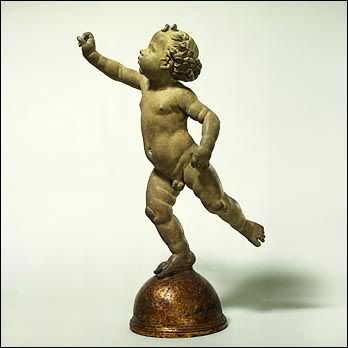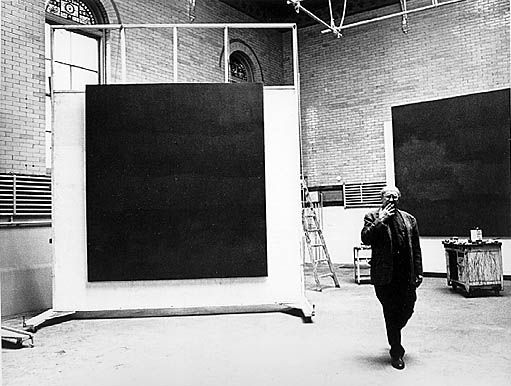

(What better place to be than poised on a globe. Say hello to Putto, he may hear you.)
A shape is a two-dimensional(p.106) form(p.36) which occupies an area with identifiable boundaries. Rothko used shapes in his murals to create such a visually dynamic balance between the figure and ground that ones eyes have trouble distinguising the figure, that which we detach and focus on, from the ground or surrounding. Verrochio's work uses the three-dimensional space(p.106), which our bodies occupy, to cast emphasis on Putto's limbs, which form distinct directional lines. These directional lines create a "decisive movement" that invites the observer into Putto's world to see exactly, for what he's reaching.
Both artists use line, but in completely different contexts. Line is a path traced by a moving point. When observing Verrochio's work our eyes trace a persitently flowing line from Putto's dangling...foot, along his carefully balanced torso, to his outstretched arm, then off into space. The line, Putto's eyes follow, enforce this upward and outward rhythmic movement as well. In Rothko's, 'Chapel Murals', the lines are created by the varying brush strokes and warm(p.95) red hues(p.96) he shapes on the picture plane(p.106). The thin "lines" between the grounds and the figures dance before our eyes, creating a sort of meditative experience, in which they appear to dissapear and reappear into the background.

(Rothko in his 69th Street studio with Rothko Chapel murals, c. 1964, © Hans Namuth Estate, courtesy Center for Creative Photography, The University of Arizona)
In conclusion, both atrists used many of the same design elements. How they employed the design principles, are of a completely distinguishing nature.
All page numbers are in reference to terms found in Mark Getlein's text, 'Living With Art'.

1 comment:
Hi, Jason,
I loved the U-Tube video on Rothko. He is one of my favorite artists.
Nice job on the essay, but where is your color game, essay #4 and #5?
Post a Comment